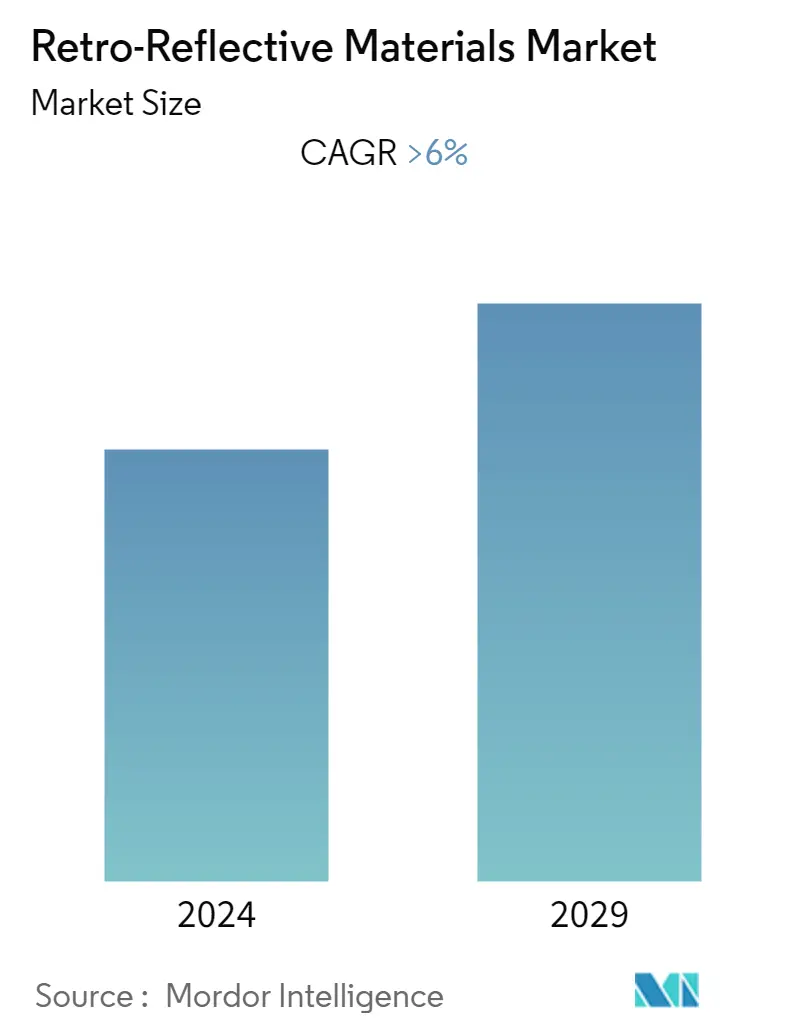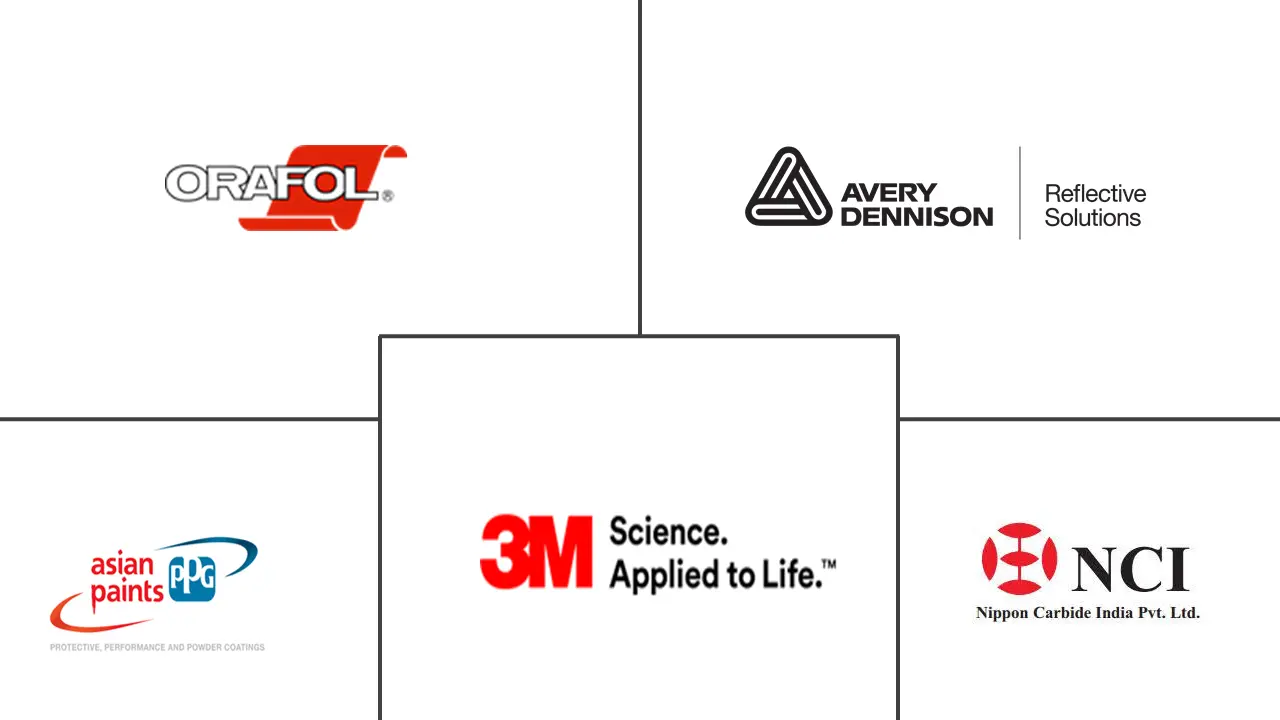Market Size of Retro-Reflective Materials Industry

| Study Period | 2019 - 2029 |
| Base Year For Estimation | 2023 |
| CAGR | > 6.00 % |
| Fastest Growing Market | Asia Pacific |
| Largest Market | Europe |
| Market Concentration | Low |
Major Players
*Disclaimer: Major Players sorted in no particular order |
Retro Reflective Materials Market Analysis
The market for retro-reflective materials is expected to grow at a CAGR of more than 6% globally during the forecast period (2022-2027).
The Covid pandemic has affected the retro-reflective materials market negatively majorly due to the disruptions in work and lockdown disruptions. End-user industries such as Automotive observed a decline in both production and sales, whereas Industrial end-user industries had to face repeated shutdowns with each passing wave of pandemic cases.
- Increasing applications of road safety products and the growing demand from the automotive industry in developing countries are driving the market growth.
- The outbreak of COVID-19 is expected to hinder the market growth of the retro-reflective materials market during the forecast period (2022-2027).
- Asia Pacific region is expected to dominate the global market and is estimated to witness highest growth rate in the forecast period.
Retro Reflective Materials Industry Segmentation
Retroreflective materials have the ability to reflect incident energy back towards its source regardless of the direction of incidence, hence they are perceived as an innovative solution to reduce the energy required for cooling and to improve urban microclimates. The Retro-Reflective Materials Market report segmentation includes Technology Type, Product Type, End-user Industry, and Geography. By Technology Type the market is segmented in Ceramic Beads, Glass Beads, and Microprismatic, segmentation in Product Type includes Films, Sheets and Tapes, Paints and Inks, and Other Types, in End-user Industry, the segmentation includes Automotive, Industrial, Construction, Textile, and Other End-user Industries and in terms of Geography into Asia-Pacific, North America, Europe, South America, and Middle-East and Africa. The report offers market size and forecasts for retro-reflective materials in terms of revenue (USD million) for all the above segments.
| Technology | |
| Ceramic Beads | |
| Glass Beads | |
| Microprismatic |
| Product Type | |
| Films, Sheets and Tapes | |
| Paints and Inks | |
| Other Types |
| End-user Industry | |
| Automotive | |
| Industrial | |
| Construction | |
| Textile | |
| Other End-user Industries |
| Geography | |||||||
| |||||||
| |||||||
| |||||||
| |||||||
|
Retro-Reflective Materials Market Size Summary
The retro-reflective materials market is poised for significant growth, driven by increasing applications in road safety and rising demand from the automotive sector, particularly in developing countries. These materials, which reflect light back to its source, are essential for enhancing visibility and safety in various industries, including construction, mining, infrastructure, textiles, and automobiles. Despite the challenges posed by the COVID-19 pandemic, which led to disruptions in production and a temporary decline in demand, the market is expected to recover and expand. The Asia-Pacific region is anticipated to lead the global market, supported by its robust automotive industry and ongoing developments in construction and textile sectors.
In the automotive industry, retro-reflective materials are utilized to improve vehicle visibility at night, thereby reducing the risk of collisions. The construction sector employs these materials in signboards, apparel, and vehicles to enhance safety on sites. Additionally, the growing emphasis on traffic safety systems is driving the demand for these materials in road signage and markings. The market is characterized by fragmentation, with numerous players such as 3M Company, ORAFOL Europe GmbH, and Avery Dennison Corporation competing for market share. Despite the pandemic's impact, the long-term growth prospects remain strong, fueled by the expanding automotive and construction activities in Asia-Pacific and the increasing focus on road safety.
Retro-Reflective Materials Market Size - Table of Contents
-
1. MARKET DYNAMICS
-
1.1 Drivers
-
1.1.1 Increasing Applications for Road Saftey Products
-
1.1.2 Growing Demand from the Automobile Sector
-
-
1.2 Restraints
-
1.3 Industry Value Chain Analysis
-
1.4 Porters Five Forces Analysis
-
1.4.1 Threat of New Entrants
-
1.4.2 Bargaining Power of Buyers
-
1.4.3 Bargaining Power of Suppliers
-
1.4.4 Threat of Substitute Products
-
1.4.5 Degree of Competition
-
-
-
2. MARKET SEGMENTATION
-
2.1 Technology
-
2.1.1 Ceramic Beads
-
2.1.2 Glass Beads
-
2.1.3 Microprismatic
-
-
2.2 Product Type
-
2.2.1 Films, Sheets and Tapes
-
2.2.2 Paints and Inks
-
2.2.3 Other Types
-
-
2.3 End-user Industry
-
2.3.1 Automotive
-
2.3.2 Industrial
-
2.3.3 Construction
-
2.3.4 Textile
-
2.3.5 Other End-user Industries
-
-
2.4 Geography
-
2.4.1 Asia-Pacific
-
2.4.1.1 China
-
2.4.1.2 India
-
2.4.1.3 Japan
-
2.4.1.4 South Korea
-
2.4.1.5 Rest of Asia-Pacific
-
-
2.4.2 North America
-
2.4.2.1 United States
-
2.4.2.2 Canada
-
2.4.2.3 Mexico
-
-
2.4.3 Europe
-
2.4.3.1 Germany
-
2.4.3.2 United Kingdom
-
2.4.3.3 France
-
2.4.3.4 Italy
-
2.4.3.5 Rest of Europe
-
-
2.4.4 South America
-
2.4.4.1 Brazil
-
2.4.4.2 Argentina
-
2.4.4.3 Rest of South America
-
-
2.4.5 Middle-East and Africa
-
2.4.5.1 Saudi Arabia
-
2.4.5.2 South Africa
-
2.4.5.3 Rest of Middle-East and Africa
-
-
-
Retro-Reflective Materials Market Size FAQs
What is the current Retro-Reflective Materials Market size?
The Retro-Reflective Materials Market is projected to register a CAGR of greater than 6% during the forecast period (2024-2029)
Who are the key players in Retro-Reflective Materials Market?
3M Company , ORAFOL Europe GmbH , Avery Dennison Corporation , Nippon Carbide Industries Co., Inc and Asian Paints PPG are the major companies operating in the Retro-Reflective Materials Market.

